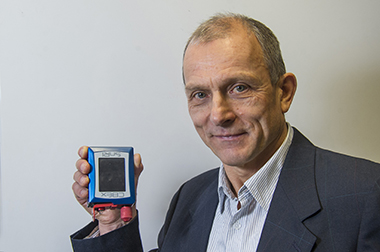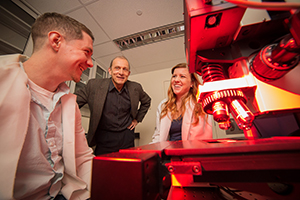Chemist’s Forensic Tool Can Determine Saliva as Male or Female
Portable scanners to analyze saliva, other body fluids, may soon be available to law enforcement
 |
|
Chemist Igor Lednev displays a portable Raman spectroscopy scanner. (Photo by Mark Schmidt) |
ALBANY, N.Y. (January 17, 2017) – Using laser technology to catch criminals is no longer futuristic in the lab of Igor Lednev.
Lednev, a chemistry professor at the University at Albany, has released findings on a new method for determining a culprit’s sex with up to 92 percent accuracy based on saliva left behind at a crime scene.
The method relies on Raman spectroscopy, a technology that measures the intensity of scattered light by shining lasers on a sample. Since no two compounds produce the same Raman spectrum, the measurements are unique, almost like a fingerprint. The process is also nondestructive, allowing for the preservation of the material for DNA analysis.
Lednev and his research team analyzed 60 saliva samples in their lab – 30 male and 30 female – using a desktop Raman spectrometer. The team searched for trends and differentiations in sample measurements to correctly identify the sex of each donor. Their results were published in Analytical Chemistry.
“This was a proof-of-concept study and our findings have successfully proven the usefulness of Raman spectroscopy in determining sex through saliva,” said Lednev, also a member of The RNA Institute. “We now hope to apply this method using a portable instrument and more realistic samples to simulate crime scene evidence. This could include using traces of saliva deposited onto common substrates."
 |
|
Lednev works with Ph.D. candidates Kyle Doty (left) and Claire Muro. (Photo by Paul Miller)
|
Raman spectroscopy is an analytical chemistry technique that has been around for decades. Recent advances have made the technology’s measurements more accurate and commercially viable. Portable instruments (about the size of a Nintendo Game Boy) are already available for purchase.
Lednev’s saliva findings are the first of a multidimensional Raman spectroscopy project. His team, led by Ph.D. chemistry candidate Claire Muro, also is analyzing laser measurements from four other body fluids including peripheral blood, semen, sweat and vaginal fluid.
Ultimately, the researchers envision a portable “point-and-shoot” Raman spectroscopy scanner that can be used to identify the type of body fluid, determine if it’s human or animal in origin, report the estimated time of deposition, and predict key suspect characteristics such as sex, race and age.
Lednev believes these types of handheld Raman tools could be used by law enforcement within three to five years. His team is working with the New York State Police Crime laboratory to make the technology practical for investigators.
“After finding what appears to be a biological stain at a crime scene, a forensic investigator would simply need to scan the evidence to collect the necessary data. There’s no interpretation of the spectra needed. Once the laser hits the sample, they’ll get instantaneous answers through automatic software,” Lednev said.
Lednev’s latest research adds to the University’s groundbreaking work in forensics. Last year, assistant chemistry professor Jan Halámek was featured by dozens of media outlets including the New York Times and National Geographic for his own techniques to identify suspects based on body fluids and fingerprints at crime scenes.
The two are considering several possibilities for collaboration.
Lednev’s laboratory has been funded by the National Institute of Justice (NIJ) for eight consecutive years for a total of about $2.2 million. He’s also received a separate NIJ grant to analyze gunshot residue through Raman spectroscopy, and investment from SUNY’s Technology Accelerator Fund. His team has published over 50 articles in peer-reviewed journals over the past decade.
You can learn more about Lednev by visiting his official University expert page.
![]() For more news, subscribe to UAlbany's RSS headline feeds
For more news, subscribe to UAlbany's RSS headline feeds
A comprehensive public research university, the University at Albany-SUNY offers more than 120 undergraduate majors and minors and 125 master's, doctoral and graduate certificate programs. UAlbany is a leader among all New York State colleges and universities in such diverse fields as atmospheric and environmental sciences, business, education, public health,health sciences, criminal justice, emergency preparedness, engineering and applied sciences, informatics, public administration, social welfare and sociology, taught by an extensive roster of faculty experts. It also offers expanded academic and research opportunities for students through an affiliation with Albany Law School. With a curriculum enhanced by 600 study-abroad opportunities, UAlbany launches great careers.


